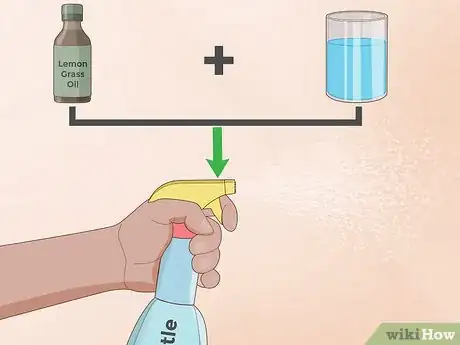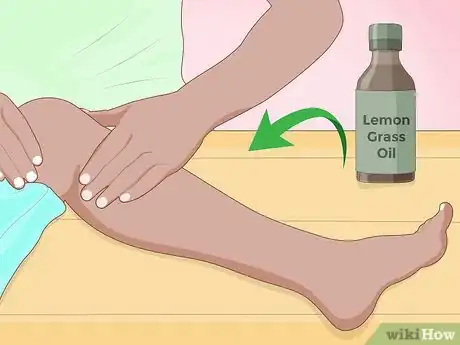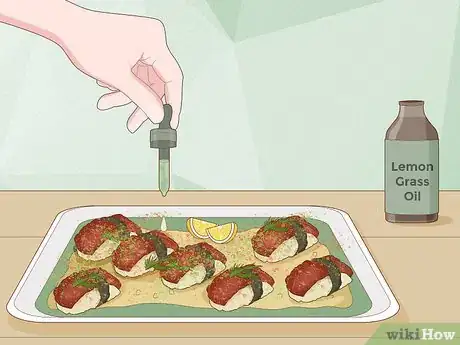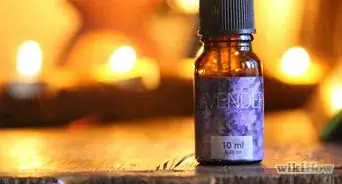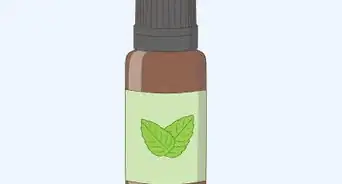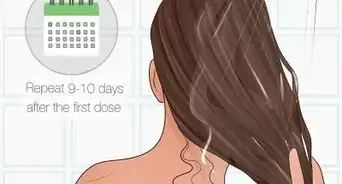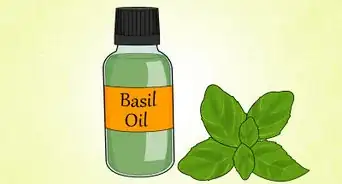This article was co-authored by wikiHow Staff. Our trained team of editors and researchers validate articles for accuracy and comprehensiveness. wikiHow's Content Management Team carefully monitors the work from our editorial staff to ensure that each article is backed by trusted research and meets our high quality standards.
There are 9 references cited in this article, which can be found at the bottom of the page.
This article has been viewed 21,980 times.
Learn more...
Lemongrass oil, derived from the leaves of the lemongrass plant, carries a recognizable and soothing scent. However, it doesn’t simply smell good – it’s a versatile homeopathic remedy that has powerful anti-inflammatory and calming properties. Applied topically, mixed into food or drink, or diffused in the air, it can help you address a range of issues as broad as stomach discomfort, anxiety, and acne. If you use it with purpose and care, it just might become your new favorite natural product.
Steps
Applying Lemongrass Oil to Your Skin
-
1Dilute your lemongrass oil before application. In its highest concentrations, lemongrass oil can cause irritation of the skin and mucous membranes. In order to prevent adverse reactions, add 24 drops of water per ounce of essential oil before using it on your skin.[1]
- Before extensive use, brush the solution on a small patch of skin. If you experience any kind of irritation, stop using the oil immediately.[2]
-
2Apply lemongrass oil to minor wounds. Lemongrass oil has antiseptic properties, and can prevent minor cuts, scrapes, and burns from becoming infected. Use diluted lemongrass oil (or an antiseptic cream that lists it as a primary ingredient) to ensure that your wounds heal quickly.[3]Advertisement
-
3Brush your face with diluted lemongrass oil to soothe active acne. Mix 2 millilitres (0.068 fl oz) of lemongrass oil with 100 millilitres (3.4 fl oz) of grapeseed oil, water, or witch hazel until thoroughly combined. Gently apply it to the area affected by acne using a brush or a sponge, taking care to keep the mixture away from your eyes, nose, and mouth.
- Lemongrass oil can kill the bacteria that causes acne, which helps to soothe and clear blemishes.[4]
-
4Use a diluted lemongrass oil spray as insect repellent. Spraying your skin with a mixture of lemongrass oil and water can help you ward off pesky creatures like mosquitoes and flies. Dilute the oil as you would for any other use on skin.Then, pour the mixture into a small, clean spray bottle and apply.
- Lemongrass is related to citronella – a fragrant oil often used against bugs – and can be a similarly effective anti-bug agent.[5]
-
5Massage stiff or painful joints with diluted lemongrass oil. Lemongrass oil’s anti-inflammatory properties extend beyond killing bacteria and calming acne. Treating sore or stiff joints with lemongrass oil can promote increased comfort and flexibility. Dilute the oil, then massage it directly and gently into the painful area.[6]
Adding Lemongrass Oil to Food and Drink
-
1Use only small amounts of lemongrass oil if you plan to ingest it. Essential oils consumed in large quantities are at best overpowering, and at worst a threat to your health. Adding a drop is more than enough.
- Dipping a toothpick in pure (or diluted) essential oil and stirring it into into smaller meals and beverages is an easy and appropriate dosing method.
-
2Use lemongrass oil to flavor recipes. Many delicious dishes incorporate the flavor of lemongrass. Thai food is particularly renowned for curries and stir-fries rich with its bright aroma. Add just a drop next time you’re mixing up a curry or a stir fry – the whole dish will be infused with its flavor.
-
3Drink tea with lemongrass essential oil to fight stomach pain and insomnia. Lemongrass has been used in folk medicine for centuries to soothe upset stomachs and produce a general sense of calm.[7] Next time you have a stomachache – or trouble sleeping – try drinking a hot cup of tea with lemongrass oil to put yourself at ease.
- Many teas made with lemongrass leaves are available, but you can conveniently add the stomach-soothing properties of the plant to any beverage by stirring it with a lemongrass oil-soaked toothpick, as suggested above.
Using Lemongrass Oil in Aromatherapy
-
1Diffuse your lemongrass oil with a diffuser, an inhaler, or a sachet. There are many ways to infuse your surroundings with the fragrance of essential oils. You can purchase a diffuser for use in your home, or you can create your own portable sachet or inhaler.[8]
- To make a sachet, staple together two pieces of fabric around a bit of soft stuffing (like cotton or cloth scraps) that’s been dabbed with lemongrass essential oil. Stick it in your pocket, and you’ll be accompanied by the fragrance of lemongrass all day.
- To create an essential oil “inhaler", fill a small vial or jar halfway with coarse, chunky rock salt. Put 5-10 drops of lemongrass essential oil into the vial and shake it vigorously. Then, whenever you want an intense burst of lemongrass scent, uncork the vial and inhale gently.
-
2Diffuse lemongrass oil in your room to ensure a good night’s rest. Lemongrass essential oil can have a mild sedative effect, so if you're struggling with insomnia, it could help you get to sleep. Try using a diffuser to spread the scent around your sleeping area, placing a sachet on your bedside table, or taking few gentle breaths from your inhaler before heading to bed.[9]
-
3Use your diffuser to fight anxiety before stressful events. Inhaling the fragrance of lemongrass before a worry-provoking task or event can reduce your tension and anxiety. Try using your inhaler before a big test, or carrying a sachet on your way to an important interview.[10]
References
- ↑ https://achs.edu/blog/2017/08/15/aromatherapy-essential-oil-dangers-and-safety/
- ↑ https://www.painpathways.org/essential-oils/
- ↑ https://www.organicfacts.net/health-benefits/essential-oils/health-benefits-of-lemongrass-essential-oil.html
- ↑ https://www.researchgate.net/publication/238635275_In_vitro_bioactivities_of_essential_oils_used_for_acne_control
- ↑ https://www.ncbi.nlm.nih.gov/pubmed/12046869
- ↑ https://www.painpathways.org/essential-oils/
- ↑ https://www.sciencedirect.com/science/article/pii/037887419190187I?via%3Dihub
- ↑ https://www.thisisinsider.com/how-to-use-diffuse-essential-oils-2018-6#you-can-create-a-scented-pouch-2
- ↑ https://universityhealthnews.com/daily/energy/trouble-sleeping-try-these-essential-oils-for-sleep/



